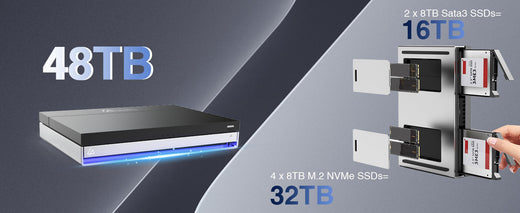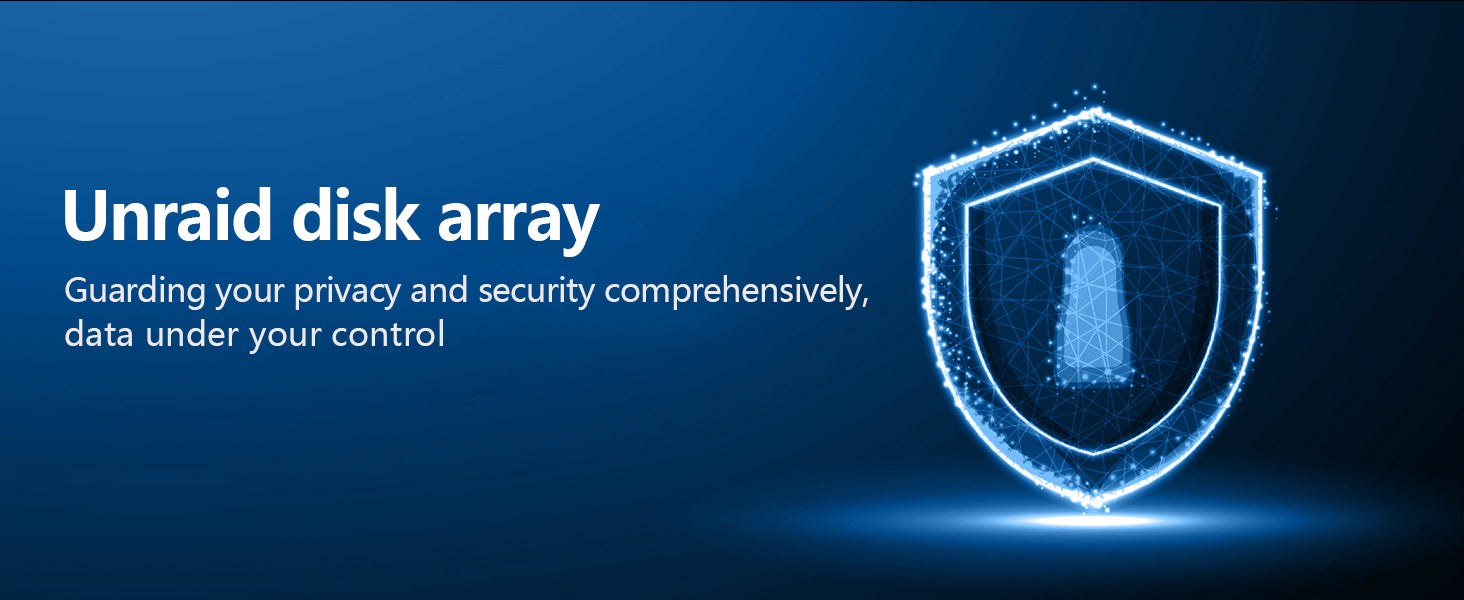Data storage doesn’t always come up in casual conversations (unless you’re hanging out with tech-savvy individuals, in which case, yes).
But, if you’re reading this, you likely have data to store, share, or protect, and you know that USB drives are no longer enough. What you need is a more efficient, reliable, and cost-effective solution. Enter SATA NAS.
A SATA NAS is a Network Attached Storage system that uses SATA (Serial ATA) hard drives to store and manage data. It’s a centralized hub that allows you to keep, share, and back up your files securely - all without breaking the bank.
It’s the best option for home users, small businesses, and anyone tired of juggling multiple storage solutions. Is it the perfect fit for you, too? Let’s find out!
What is SATA NAS?
If you’re wondering how to organize your growing file collection, a SATA NAS is the answer. The term “SATA” refers to the interface that connects the hard drives inside the NAS system. Offering a fantastic balance of speed, capacity, and affordability, it allows you to store your documents, movies, and photos.
A SATA NAS system isn’t just a box of hard drives; it’s a smart solution that connects to your home or office network, allowing your laptops, desktops, smartphones, and even smart TVs to access your data. It’s like your personal cloud. But, it offers more control, better security, and no monthly subscription fees.
Differences of SATA NAS and HDD NAS
You might have heard of HDD NAS and you’re wondering if it’s the same as the SATA NAS. The main difference between them is that HDD NAS are designed to run continuously, while SATA NAS only run when accessed. Here’s the breakdown of the other dissimilarities:
SATA vs. Other HDD Interfaces
Not all hard drives are created equal. SATA is one type of hard drive interface that offers faster data transfer and a streamlined connection process. Other HDD interfaces, like SAS (Serial Attached SCSI) and NVMe, on the other hand, cater to different needs. SATA drives focus on affordability and capacity, while SATA and NVMe lean towards enterprise-grade performance.
Consumer vs. Enterprise
HDD NAS can encompass various interfaces, but for most consumers and small businesses, SATA is the standard. SAS drives might sound fancy, but they’re often overkill for home setups. Plus, they’re more expensive.
Real-World Performance
SATA drives offer a great balance of speed and storage. Although they’re not as fast as SSDs, they excel in storing terabytes of data affordably, making them the MVPs of the storage world.
In short, when people talk about HDD NAS, they’re likely referring to SATA NAS—because it’s the most practical choice for general use.
The Benefit of a SATA NAS
A SATA NAS is an excellent solution to effectively manage, store, and share data. Built on Serial ATA (SATA) technology, it provides a reliable and cost-effective means of centralizing data storage while ensuring accessibility across connected devices in a network.
So, why should you care about SATA NAS specifically? Let’s break it down:
Cost-Effectiveness
SATA drives are significantly more affordable than SSDs or SAS drives, making them ideal for users who need plenty of storage without breaking their budgets. Whether you’re backing up family photos or managing a small business’s data, you’ll appreciate the value.
High Storage Capacity
SATA drives come in massive capacities (up to 20TB per drive), making it easy to scale up your storage as needed. Need to store your 4K movie collection, years of vacation photos, or an entire team’s worth of project files? No problem. SATA NAS got you covered!
Reliability and Longevity
SATA drives are workhorses. When paired with a robust NAS like the LincStation N1, they offer excellent reliability, especially in RAID configurations. They’re built to last, so your data stays safe against drive failures.
Wide Compatibility
One of SATA’s biggest strengths is its universal compatibility. SATA drives work seamlessly with most NAS devices, including ours (wink, wink). The LincStation N1, for instance, is optimized for performance and efficiency. So, whether you’re a DIY techie or a plug-and-play enthusiast, a SATA NAS is for you!
Energy Efficiency
Running multiple hard drives can be power-intensive, but SATA drives are relatively energy-efficient, especially when combined with a low-power NAS solution. It’s the greener choice for long-term, storage.
How to Choose a NAS SATA NAS
Choosing the right SATA NAS is essential for meeting your specific data storage, management, and sharing needs. With various options available, it might feel like a tech jungle, but don’t worry—we’ve got your back. Here’s how to find the perfect fit:
Assess Your Storage Needs
Start by asking yourself, “What am I storing?” If you’re backing up family photos, a 2-bay SATA NAS like the LincStation N1 might be enough. For larger businesses or serious data hoarders, consider a multi-bay option.
Check for Compatibility
Ensure the NAS supports SATA drives. (Hint: The LincStation N1 does.) Also, check the maximum capacity per bay and the total storage the system can handle. The N1 has 6-bay NAS storage and 2 bay 2.5-inch SATA SSD slot.
Think About Performance
Decide if you need 5400 RPM drives for quiet, energy-efficient storage or 7200 RPM drives for faster access. If you’re streaming media or running a small server, then performance matters.
Consider Features and Usability
A good SATA NAS isn’t just about hardware—it’s about software too. Look for features like remote access, backup automation, and app integrations. The LincStation N1 comes with a user-friendly interface that even tech novices can navigate.
Factor in Scalability
If your storage needs are likely to grow, choose a NAS that supports expansion. Future-proofing your setup will save you headaches later.
Stick to Your Budget
Remember, affordability is a key benefit of SATA NAS. You don’t have to overpay for features you won’t use anymore.
Choosing the right SATA NAS requires a thoughtful assessment of your specific needs and priorities. So, take time to research and select wisely so your investment will meet your storage needs for both now and in the future.
Why the LincStation N1 is the SATA NAS You Need
We’d be remiss if we didn’t mention why the LincStation N1 stands out. Here’s what makes it the top choice:
- Performance Meets Simplicity: The LincStation N1 is designed for home and small business users. It combines robust performance with an intuitive setup process. No tech degree is required.
- Energy Efficiency: Optimized for low power consumption, getting the N1 can save you money in the long run.
- Scalability: With multiple bays and RAID support, the N1 grows with your storage needs.
- Affordability: Competitively priced, it’s an excellent investment for anyone serious about data storage.
Conclusion
Regarding data storage, a SATA NAS offers the ultimate blend of reliability, capacity, and affordability. Whether managing personal files or running a small business, it’s a practical solution that ticks all the boxes. Pairing it with a top-tier device like the LincStation N1 takes away all your data storage woes.
Ready to take the plunge? Explore the LincStation N1 today and see why it’s the smart choice for your storage needs. Because when it comes to your data, you deserve nothing but the best.




Dejar un comentario
Todos los comentarios se revisan antes de su publicación.
Este sitio está protegido por hCaptcha y se aplican la Política de privacidad de hCaptcha y los Términos del servicio.